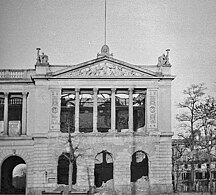New Theater (Leipzig)
The New Theater was the predecessor of the Leipzig Opera House . The late classicist - historicist building stood on the north side of Augustusplatz from 1868 until it was destroyed in World War II .
history
It was built in the years 1864–1868 by Carl Ferdinand Langhans on the north side of Augustusplatz . Detailed planning and construction management was in the hands of the Leipzig architect Otto Brückwald . At the opening on January 28, 1868, Goethe's Iphigenie was given on Tauris . The New Theater offered 1700 seats and 300 standing places and was intended for drama , opera and ballet . Since the house proved to be excellent for opera but unsuitable for drama, the drama moved entirely to the Alte Theater am Fleischerplatz (Theaterplatz, today Richard-Wagner-Platz), while the New Theater advanced to become the Leipzig Opera.
1935–1938 the auditorium, stage and orchestra pit were rebuilt. During the Second World War , on December 4, 1943, an Allied air raid destroyed the building. The stage was still being used until the day before the destruction. The ruins were torn down in 1950 and, after several competitions and preliminary projects, the new opera was built in the same place from 1956 to 1960. Although it was built in line with contemporary tastes, some features are reminiscent of the New Theater .
The Dreilinden house in the Leipzig district of Lindenau served as the opera's alternative quarters from 1945 to 1960 .
Sculpture jewelry
The building, which was largely destroyed in air raids in 1943, had remarkable sculptural decorations. The gable field above the vestibule, depicting the poetry that inspires the other arts , was modeled by the sculptor Hugo Hagen , as well as the large gable acroteries Apollo, Klio and Calliope , the side acroteries are works by Eduard Lürssen . The side gable reliefs Bacchuszug and Ceres as a cultural bringer were modeled by August Wittig , the central acroteries above and also from the rear are by Emil Schiele . The sculptor Lürssen also created three pairs of winged Victorias and metopes on the back wall of the vestibule, representing the muses Polyhymnia , Erato , Terpsichore , Urania and Euterpe , each accompanied by two geniuses . The acroteries of the square central building, large candelabra held by griffins, are in turn the work of sculptor Wittig, who also modeled the eight large candelabra belonging to the building, which are carried by female geniuses. The theater building also included a group of fountains Amor playing with the dolphin by the sculptor Lürssen. With the exception of the reliefs made of artificial stone, the sculptures were all made in Berlin from bronzed cast zinc.
The sculptural elements that survived the bombing raids were removed when the ruins were demolished.
In the vestibule in 1868 the busts of 15 poets from old and modern times, all modeled by the sculptor Hermann Knaur : Sophocles , Aristophanes , Plautus , Hans Sachs , Shakespeare , Calderón , Lope de Vega , Corneille , Goldoni , Molière , Oehlschläger , Friedrich Hebbel , August Wilhelm Iffland , August von Kotzebue and Adolf Müllner .
Parts of the tympanum frieze, formerly on the front gable (2013)
World premieres (selection)
- 1902 - Orestes by Felix Weingartner
- 1927 - Jonny plays by Ernst Krenek
- 1930 - The rise and fall of the city of Mahagonny by Bertolt Brecht and Kurt Weill
- 1931 - The Flower of Hawaii by Paul Abraham
- 1937 - viola by Ludwig Schmidseder
- 1943 - Catulli Carmina by Carl Orff
See also
literature
- Birk Engmann: Building for Eternity: Monumental architecture of the twentieth century and urban planning in Leipzig in the fifties. Sax-Verlag, Beucha 2006, ISBN 3-934544-81-9 .
- Friedrich Hofmann : A citizen's temple of art . In: The Gazebo . Issue 49, 1866, pp. 771-774 ( full text [ Wikisource ]).
- In the foyer of an art temple . In: The Gazebo . Issue 10, 1872, pp. 160–162 ( full text [ Wikisource ]).
Web links
Individual evidence
- ^ Annette Menting : Leipzig. Architecture and art. Reclam's city guide. Reclam, Stuttgart 2015.
- ↑ Illustrirte Zeitung , No. 1249, June 8, 1867, p. 397
- ↑ Illustrirte Zeitung , No. 1303, June 20, 1868, p. 438
Coordinates: 51 ° 20 ′ 25 ″ N , 12 ° 22 ′ 53 ″ E






